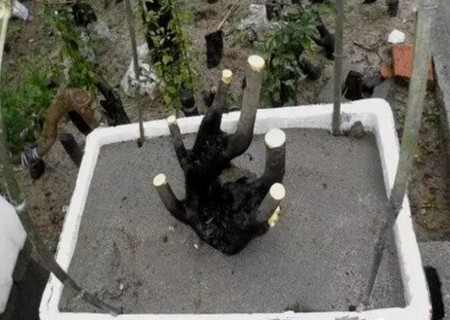How to maintain the pile under the mountain of Finch plum
Sparrow plum, also known as thorn, sparrow plum vine, sour fruit, sour young tree, is a deciduous climbing shrub of the family Rhamnaceae. The bark is grayish brown and the branchlets are slender with needles. Leaves opposite, ovate or elliptic, margin serrulate, thinly leathery and bright green. Light yellow flowers in autumn and winter, drupe nearly spherical, purple-black when ripe, edible, sour and sweet. It is one of the main tree species of Chinese stump bonsai, one of the five famous trees in Lingnan bonsai, and also one of the bonsai plants exported to the United States after China's entry into WTO.
Finch plum branches are thin and long, the leaves are small leathery, green and shiny. Its old pile tree shape is peculiar, the bark is mottled, some form withered holes and rotten holes, simple and elegant, the view has a sense of old and strong, is one of the commonly used tree species in the production of bonsai. The following is to introduce the cultivation and maintenance of sparrow plum downhill pile.
The treatment of Finch Plum under the mountain pile:
After the sparrow plum stump goes to the planting site, it is necessary to carefully observe and analyze the stump, select the best viewing surface, and analyze the choice of poles and branches. Trim the root according to the requirement of potting later. Some beginners are inexperienced and can consult those with experience. Don't get sawed off casually. It's impossible to recover from sawing off. If there are not many fibrous roots, they can be planted first and cut off several times after survival. The sprouting ability of some tree species is not strong, the pile is very old, and more branches should be left.
Those dug back in winter should also be longer, and the buds in the ideal position will make the final choice after sprouting. After pruning, the sharp mouth of the branch and the large root saw should be sealed once or twice, apply the sharp mouth with wax, white glue or paint, and apply a few more times with a large opening. Ensure the moisture of the pile body, which is beneficial to the germination and survival. Then the root had better be disinfected with potassium permanganate, which can also promote rooting. Some of the difficult ones can be applied to the heel with mud and rooting powder.
The cultivation of sparrow plum downhill pile:
After doing a good job in the preliminary work, the land type is higher and the drainage is better and faster, there are several methods to choose, which can be treated separately according to the situation.
1. Load directly, add soil after digging the pit, and fill the soil and roots tightly with wooden sticks. There should be no gaps. The disadvantage is that the upper basin root will still be hurt in the future, and it is not convenient for small piles to operate later. The advantages are fast growth, less water management and short molding time.
2, basin load, the disadvantage of direct basin load is that there is little basin soil, nutrition can not keep up, growth is very slow, some trees are afraid of freezing in winter, water consumption is fast in summer, and the workload is increased. The only advantage is that the root does not grow randomly.
3. Build a pool with bricks for planting. The method is to relax the pile slightly according to the size of the pile, with a height of 40-60 cm, with some coarse sand or soil in the lower layer, and the middle coarse soil at the top to plant the tree stump with cultural soil. The third method is the most commonly used at present. This method grows fast and is easy to operate in the future. the root only grows down, and the pot will not hurt the root in the future.
Maintenance of the pile at the foot of Finch Plum:
1. The heat preservation work dug back in winter should be done well. The heat preservation can be wrapped with straw, and the pile can be covered with plastic bags.
2. After choosing the planting method, water once, be sure to water thoroughly, and later see that the soil has no sense of wettability and water again.
3. Moisturizing is even more important when the temperature rises, that is, you can often spray water on the tree stump, but you can't spray too much water. Too much water will seep into the soil, and too much water in the soil will cause rotten roots. Spray it 3-5 times a day.
4. pay attention to the shade of sugarcane in direct sunlight, and you can build a shade shed to block sugarcane. The shade net can not be removed until the growth is normal in the first year, and those who like shade will not be able to do so until October.
5. After a season of growth, all the unnecessary branches can be cut off according to the shape, and the nutrients can be concentrated to supply the retained branches. According to the growth situation can be appropriate under the point of fertilizer and water, but must be light, generally 3 floating fertilizer plus 7 floating water comparison. If it is thick, it will burn the roots, and it is not a waste of previous efforts to see a tree that is already alive.
Time: 2019-06-03 Click:
- Prev

The method of making hanging bonsai DIY
Bonsai gives people a peak is too China thousand fathom, a spoon is thousands of miles of artistic feelings, affecting the feelings of the poet. For example, the poem is full of mountains for tens of thousands of miles, all in a small basin, the pool light and sky shadow are blue, and only a few bottles of water are added to the shore, which is the poet's sincere praise for the art of bonsai. Nowadays, more and more people's love for plants
- Next

How to plant mountain piles under bonsai
The determination of the transplanting time of bonsai piles has always had its own opinions. According to my own experience of planting piles, it is generally necessary to vary from time to time and from place to place, and should not be treated rigidly. The transplanting time in our southwest region should generally be free of rain, snow and frost, and deciduous trees and cypresses can be transplanted before the Waking of Insects in the early winter to the following year.
Related
- Fuxing push coffee new agricultural production and marketing class: lack of small-scale processing plants
- Jujube rice field leisure farm deep ploughing Yilan for five years to create a space for organic food and play
- Nongyu Farm-A trial of organic papaya for brave women with advanced technology
- Four points for attention in the prevention and control of diseases and insect pests of edible fungi
- How to add nutrient solution to Edible Fungi
- Is there any good way to control edible fungus mites?
- Open Inoculation Technology of Edible Fungi
- Is there any clever way to use fertilizer for edible fungus in winter?
- What agents are used to kill the pathogens of edible fungi in the mushroom shed?
- Rapid drying of Edible Fungi

